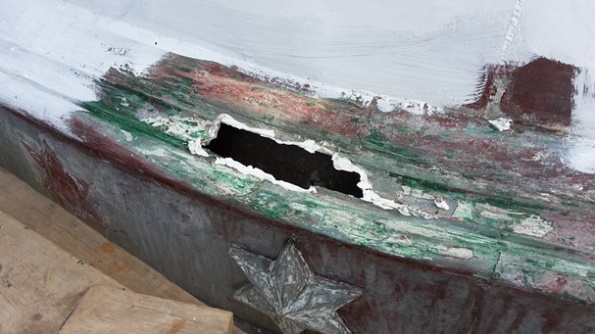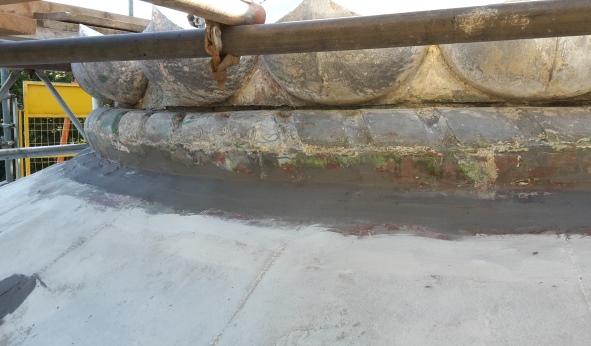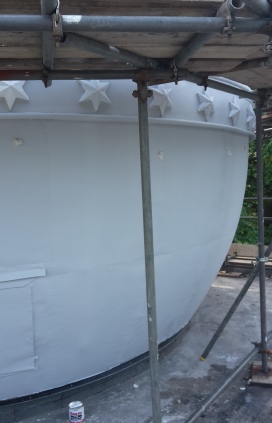The Shah Jahan Mosque in Woking, United Kingdom, was the first purpose-built mosque in England. Built in 1889, it is located 30 mi (48.3 km) southwest of London and has served as a formal place of Islamic worship for the past 128 years. Given those historical and religious associations, it is protected as a building of special interest under the National Heritage List for England registry—but that didn’t stop corrosion from slowly taking a toll on its exquisitely designed roof.
The crown jewel of the mosque is its 6.5-m (21.3-ft) diameter emerald-colored dome—included as a homage to the green-colored dome at the storied Prophet’s Mosque in Medina, Saudi Arabia—along with a band of 41 stars around its circumference and a crescent moon at the top. But over the course of 128 years, both the zinc dome and the lateral band had become significantly damaged and were showing signs of age.

“It was suffering from a large number of perforations around its circumference, as well as several large holes, due to weathering and corrosion of the metal,” says marketing representative Tom Belli of protective coatings manufacturer Belzona (Harrogate, United Kingdom), adding that the mosque’s band of stars had similarly succumbed to corrosion and a loss of shape.
All of this damage led to rainwater leaking into the mosque, which disrupted prayer times and other community events taking place at the facility.
Weld Repairs Not Viable
Since 1995, the mosque has been registered as an independent charity, which allows the local community to invest in renovation and restoration efforts to maintain the site’s original elegance.
As part of those efforts, the mosque’s representatives initially reached out to a number of companies that utilized traditional hot-work repair methods. But contractors were hesitant to use those methods because of the possibility of aggravating the problems even further.
“Due to the thin- and through-wall defects in the already fragile zinc dome, it was believed to be impossible to weld repairs without causing additional damage,” Belli explains.
As a result, a cold-applied alternative was recommended to both rebuild any through-wall defects in the existing metalwork, along with a waterproof coating for future protection on the dome. The cold-applied system specified included both a composite for metal repair and a flexible membrane for waterproofing and weatherproofing.
Metal Repair Composite
The repair composite was particularly needed for the mosque’s most damaged areas, so step one of the process was to determine where those areas were. Using scaffolding to access the dome’s heights, a contract crew carried out a series of pull-off tests on the existing coating to assess its adhesion strength.

Results from the adhesion test showed that the surface of the dome could be prepped by washing, and then specific areas could be repaired using hand tools. In this process, the applicator removed the deteriorated coating and corroded areas to create a clean and rough surface profile, Belli explains.
The chosen repair material was a two-part composite for metal repair and resurfacing based on solvent-free epoxy resin reinforced with silicon steel alloy. Fine steel mesh is incorporated into the material to rebuild and reinforce large perforations. The repair material is designed to offer extended working life, particularly for large applications where greater volumes of material are required or adequate working time at higher temperatures is needed.

According to the manufacturer, the repair material does not corrode, and also resists a wide range of chemicals. With a working life of ~35 min, the material can be mixed and cold-applied without special tools—instead using wielded brushes and hand-held squeegees—and the mechanical curing time is one day.
Flexible Membrane Solution
 With the repair composite in place and cured, the surface was 100% solid and ready for the final component of the multipronged solution—applying the flexible membrane for waterproofing.
With the repair composite in place and cured, the surface was 100% solid and ready for the final component of the multipronged solution—applying the flexible membrane for waterproofing.
The surface was sanded and again cleaned before the flexible membrane, a single-component, solvent-free, water-based roof coating, was applied in conjunction with a surface conditioner to help encourage adhesion. The flexible membrane was applied in a gray color by brush and roller.
Known for its elasticity and ability to easily conform to various contours, the system is designed to allow the surface to breathe due to its microporous structure, Belli explains.
The membrane was then painted green with a compatible coating system to restore the dome to its renowned color scheme. Left uncoated, the stars and crescent moon were subsequently gilded by the client in line with the dome’s original design.
“The works carried out look incredible,” the mosque’s specialist works manager says of the project, which was completed over the course of nine days in late 2016.
Although the mosque was never closed during the application, its picturesque green dome is now fully functional—and leaks have not been reported at the mosque in the months since its restoration.
Source: Belzona Polymerics, Ltd., www.belzona.com. Contact Tom Belli, Belzona—email: tbelli@belzona.com.